How To Practice Tattoo On Fake Skin? [Detailed Guide]
Being a tattoo artist is not an easy task. One small mistake can ruin the procedure in no time. So, it is crucial for a budding tattoo artist to practice his/her craft. One great way to practice tattoos is fake skin. So, How to practice tattoo on fake skin?
Here’s your chance to hone your skills on actual human flesh by treating practice tattoos as if they were for a paying client. If you’re just starting out, take your time and think about every little detail, just as you would if you were tattooing real skin. Keep in mind that the setting in which you are engaged in your task should be professional.
This article also covers everything about practicing tattoos on fake skin and tips & tricks to use it more efficiently.
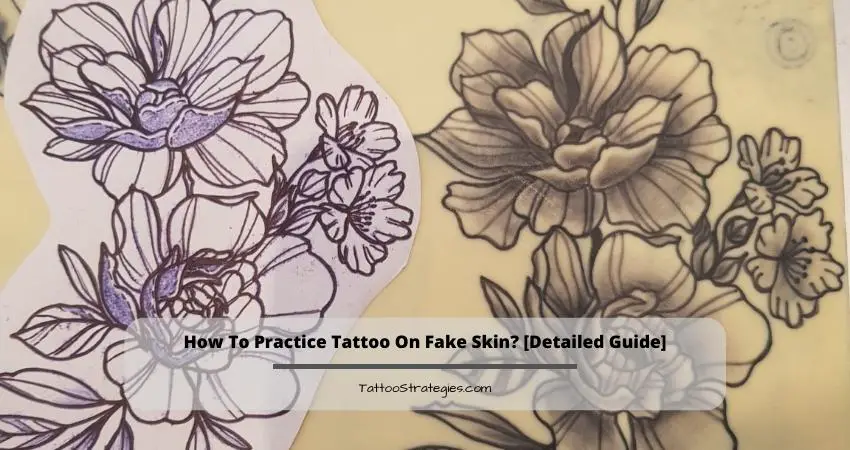
How to Practice Tattoo on Fake Skin
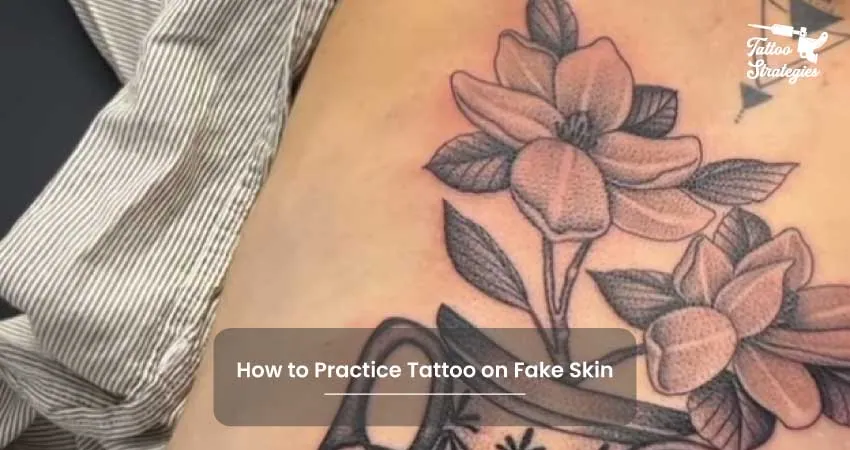
Tattoo practice skin may be helpful if used properly, but only if you know what you’re doing.
For the most realistic results with your practice sheets, try the following:
- First, get up some fake skin, thermal paper, and the tattoo design you wish to use.
- Create a duplicate using thermal paper and a thermal printer.
- third, carefully remove the image from the thermal copy.
- Using the practice skin, position the stencil as desired.
- Now that the design is set, you may try drawing its shape on your skin.
- Remove any traces of ink and maintain a clean working surface.
- Once the contours are in place, the next step is to experiment with different shading techniques until you get the desired effect.
Things to Keep in Mind Before Practicing Tattoo on Fake Skin
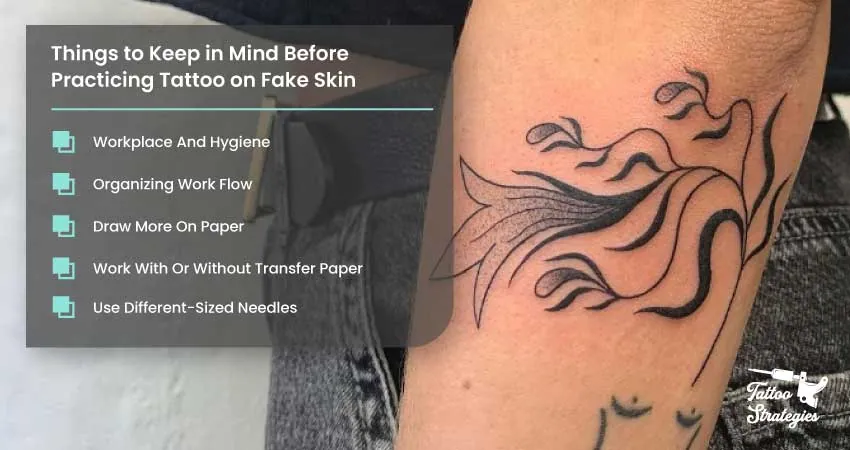
Even the professionals practice regularly to keep up with their skills. Keep these factors in mind to be an expert tattoo artist.
Workplace And Hygiene
Think about where you work before you start doing anything. How to clean the surface you are currently working on? How will you deal with the needles that have been used? How will you put everything together?
Is there anything you should know about hygiene before you start? Even if there’s no real danger, keep your work area clean and in order during your practice session.
Organizing Work Flow
Ink has a nasty tendency to smear. A trial run will help you get used to the tattoo’s presence. Gaining experience beforehand can help you avoid embarrassing ink mishaps when getting your first tattoo.
If you are right-handed, you may find that drawing the significant lines from left to right is simpler.
Draw More On Paper
Start with paper before attempting real skin. Tattoos are much easier to create if you can sketch. However, using a needle and a sharp object to prod is quite different from writing with a pen.
Work With Or Without Transfer Paper
Tattoo practice skins are useful not just for mastering transfer paper but also for perfecting free-hand methods. Check out both and see which you prefer.
Use Different-Sized Needles
Needles for tattooing may be found in a wide range of sizes. Tattoo practice skins allow the artist to try out various needle sizes without permanently altering the skin.
If you’re just getting started, it could be helpful to create a chart using a practice skin so you can easily compare the output of a line drawn in 3RL with that drawn in 9RL.
How to Make a Fake Tattoo Skin
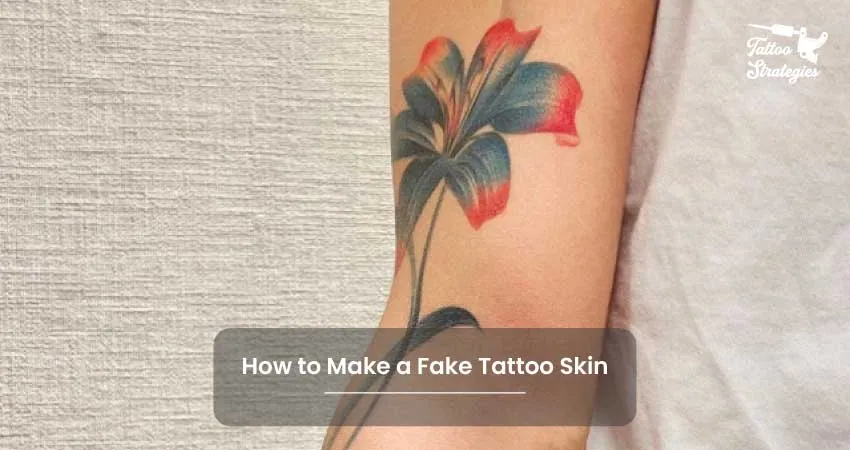
Buying practice skins might become pricey if you’re just starting out. Luckily, they are easy enough to create on your own.
It’s possible that handmade skins won’t last as long as store-bought ones, but they’re still a fantastic way to hone your skills without breaking the bank.
Things You’ll Need
There isn’t much effort involved in creating artificial skin, and most of the materials needed may be found in a typical kitchen.
- A tube of Elmer’s glue
- Synthetic sack (optional)
- Flour or cornmeal
- Hot liquid
- Paint in a flesh tone
- Bowl
- Pin for Rolling
- Use a fork or a whisk
Steps to Follow
- Put 1/4 cup of flour or cornstarch into a clean basin and add 1/3 cup warm water. The ingredients should be whisked or mixed until they become thick and difficult to stir. More cornstarch or flour may be used to get the desired consistency. The flesh should have a uniform texture and yield easily to finger pressure.
- Flatten the dough mixture using a rolling pin until you have a thin, even layer.
- Mixing a few drops of flesh-colored makeup or paint with Elmer’s glue in a plastic bag will produce a nice flesh color, perfect for practice skin. As soon as the mixture reaches the desired shade, a corner of the bag can be snipped off to facilitate effortless dispensing onto the sheet. If you don’t care about the hue, go on to the next section.
- Spread a generous amount of glue on the sheet, then roll and knead the dough-like material to incorporate the adhesive. You should repeat this process a couple of times to ensure a thorough blending of the two components. If extra glue is required, add it, but be sure to thoroughly blend it in before proceeding.
- Re-smooth the skin into a flat sheet using the rolling pin or your hands. (You may choose whatever thickness you prefer, although thinner sheets are more manageable.) Let it air dry now. The finished product should feel thick and elastic, like skin, when it dries.
Can You Reuse Tattoo Practice Skin?

Tattoo practice skins are single-use, but you can make the most of them by turning them over after you’ve covered one side.
Most practice skins can be used on either side, so if you buy one, you may as well pick one that gives you more for your money. We recommend purchasing many of these skins if you expect to put in a lot of practice time.
Can You Tattoo Leather?

Yes, you can practice tattoos on leather. Ink will last longer and look better on raw leather, also known as aniline. It is as close to a second skin as you can get from the touch; it is very smooth and silky.
Jacket leather, for example, may be coated with a plastic-like substance. Because of this, your tattoo may turn out poorly. You can get a leather deglazer at most craft shops and general merchants if you’re worried about the finish on your leather affecting the quality of your tattoo.
Where To Buy Tattoo Practice Skin

You can buy high-quality practice skin from many tattoo shops. But if you want to buy it online, you can check out sources like Beoncalls practice skin.
Benefits Of Practice Tattoo on Fake Skin
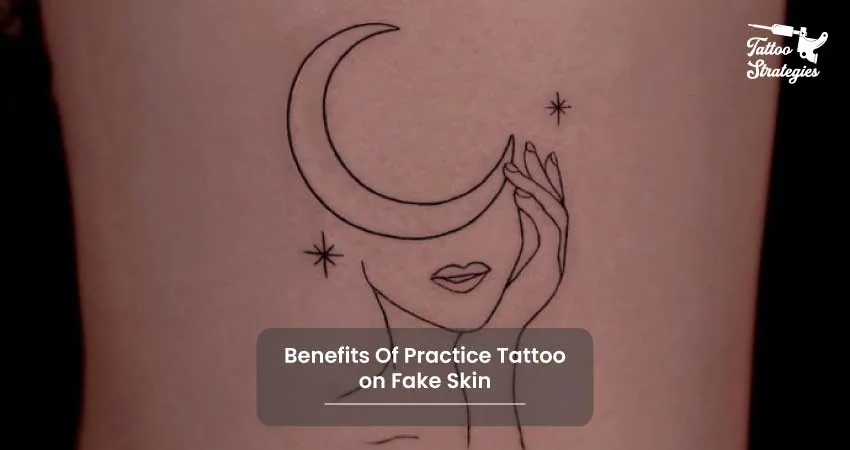
Although artificial, fake tattoo skin is created to seem as authentic as possible. Because of how realistic it looks when you touch it, using the material for the first time will feel weird.
It’s more effective than using paper or cardboard for target practice. In the past, tattoo artists had to settle with practicing their craft on animal hides or honeydew melons.
The experience doesn’t just feel real because of how the skin feels. It’s also how the tattoo machine’s needle contacts the skin. When you put ink on the artificial material, it will have the same softness and elasticity as real skin. Other ways to practice won’t give you the same results.
Conclusion
Hope the article answers your question on how to practice tattooing on fake skin.
Like tattooing real skin, you should take your time and get every detail right when you start out. Keep up an appropriate level of professionalism at all times. You’ll love the improvements you make every day. Adios!
